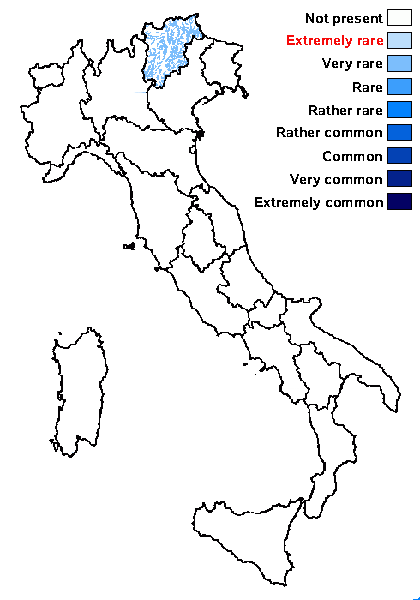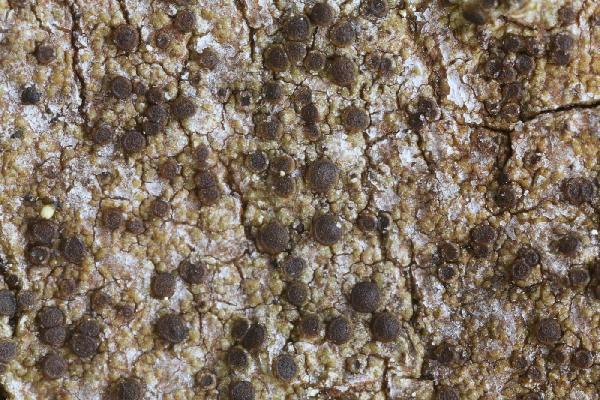Rinodina trevisanii (Hepp) Körb.
Parerga Lichenol., 1: 70, 1865. Basionym: Psora trevisanii Hepp - Flecht. Europ.: 80, 1853.
Synonyms:
Distribution: N - TAA (Nimis & al. 2018).
Description: Thallus crustose, thinly episubstratic, grey to yellowish or reddish brown, dull, most often discontinuous, sometimes becoming rimose, rarely rimose-areolate, without a distinct prothallus. Apothecia lecanorine or biatorine, adnate, usually dispersed, up to 0.35-0.5 mm across, with a dark brown, at first flat but finally often convex disc, an up to 0.05 mm thick entire, finally excluded thalline margin and often a proper margin concolorous with disc which may form a thin parathecial ring. Thalline exciple corticate or ecorticate, 25-50(-60) µm wide laterally, sometimes expanded to 30-60 µm in lower part, the cortex paraplectenchymatous, 5-10(-15) µm wide; proper exciple 5-10(-15) µm wide laterally, expanding to 20-35 µm at periphery, 30-60 µm wide if the apothecia are biatorine, red-brown in outer part; epithecium red-brown, K-; hymenium colourless, 65-90 µm high, not inspersed with oil droplets; paraphyses coherent, 2-2.5 µm thick at mid-level, the apical cells up to 3.5-4.5 µm wide, immersed in a dispersed pigment; hypothecium colourless, 30-80 µm high. Asci 8-spored, cylindrical-clavate, the K/I+ blue tholus penetrated by a faintly amyloid apical cushion with parallel or diverging flanks, the wall K/I-, surrounded by a K/I+ blue outer layer, Lecanora-type. Ascospores 1-septate, brown, ellipsoid, (14.5-)18-19.5(-23) xc (7.5-)8.5-9(-10.5) µm, Physconia-type, the wall smooth or minutely warted, the torus always well-developed, with an ontogeny of type A (apical wall thickening after septum formation). Pycnidia immersed, globose, dark red-brown. Conidia bacilliform, 3-4 x c. 1 µm. Photobiont chlorococcoid. Spot tests: cortex and medulla K-, C-, KC-, P-, UV-. Chemistry: zeorin (traces).Note: a corticolous species rarely occurring on wood, often confused with R. archaea (see Mayrhofer & Sheard 2007, Sheard 2018), with a scattered distribution throughout the Alps.
Growth form: Crustose
Substrata: bark
Photobiont: green algae other than Trentepohlia
Reproductive strategy: mainly sexual
Commonnes-rarity: (info)
Alpine belt: absent
Subalpine belt: very rare
Oromediterranean belt: absent
Montane belt: very rare
Submediterranean belt: absent
Padanian area: absent
Humid submediterranean belt: absent
Humid mediterranean belt: absent
Dry mediterranean belt: absent

Predictive model
Growth form: Crustose
Substrata: bark
Photobiont: green algae other than Trentepohlia
Reproductive strategy: mainly sexual
Commonnes-rarity: (info)
Alpine belt: absent
Subalpine belt: very rare
Oromediterranean belt: absent
Montane belt: very rare
Submediterranean belt: absent
Padanian area: absent
Humid submediterranean belt: absent
Humid mediterranean belt: absent
Dry mediterranean belt: absent

Predictive model


